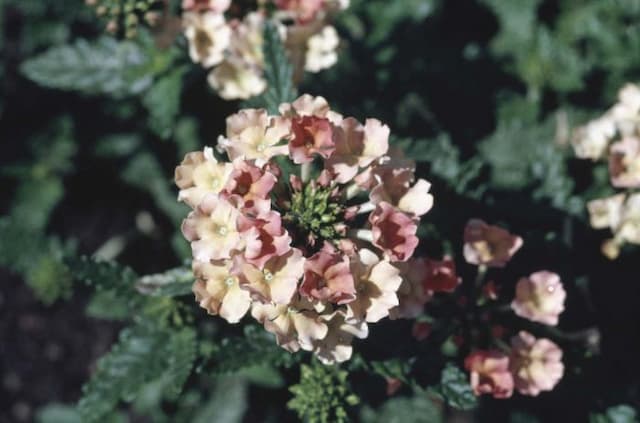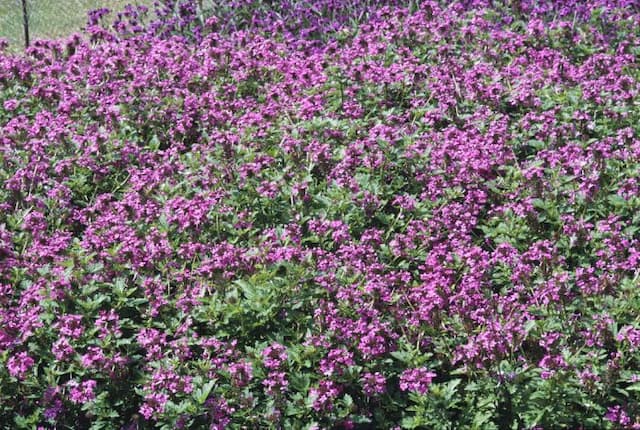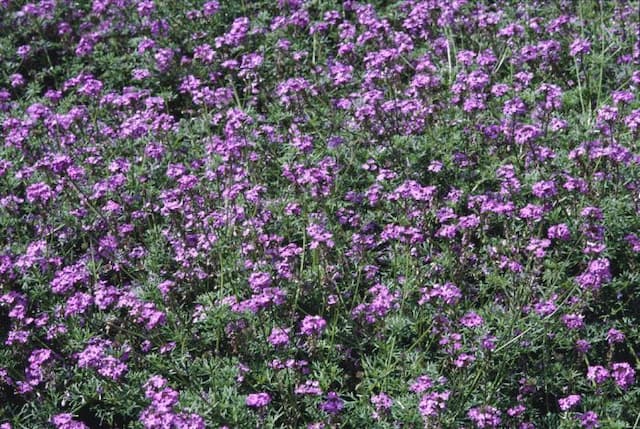Lemon Verbena Aloysia citrodora

ABOUT
Aloysia citrodora, commonly known as Lemon Verbena, is a perennial plant famed for its strong lemon scent. The plant features slender, elongated leaves which are pointed at the ends and boast a vibrant green color. These leaves are slightly rough to the touch and they emanate the characteristic citrus fragrance especially when bruised or rubbed. Lemon Verbena plants produce small, delicate flowers that are typically white or pale lilac in hue, and these blossoms grow in tiny clusters or spikes which can add a subtle visual interest to the overall appearance of the plant. The stems of Lemon Verbena are typically square-shaped, a trait common in members of the mint family, to which it is related. Overall, the appearance of Lemon Verbena is quite elegant, with a light, open, and airy structure that sways gracefully in the breeze and adds a fresh, aromatic presence to any garden or container in which it is grown.
About this plant
 Names
NamesFamily
Verbenaceae.
Synonyms
Lemon Verbena, Lemon Beebrush.
Common names
Aloysia triphylla, Lippia citriodora, Lippia triphylla, Verbena triphylla, Verbena citriodora, Aloysia citriodora, Zappania citriodora, Lantana citriodora.
 Characteristics
CharacteristicsLife cycle
Perennials
Foliage type
Deciduous
Color of leaves
Green
Flower color
White
Height
6-8 feet (1.8-2.4 meters)
Spread
3-5 feet (0.9-1.5 meters)
Plant type
Shrub
Hardiness zones
8
Native area
South America
Benefits
 General Benefits
General Benefits- Aromatic: The Aloysia citrodora, commonly known as Lemon Verbena, emits a strong lemony fragrance which is pleasant and often used in perfumes and aromatic products.
- Culinary Uses: Its leaves can be used to add a lemon flavor to fish, poultry dishes, salad dressings, jams, and beverages.
- Ornamental Plant: With its attractive pale green leaves and delicate white-purple flowers, it serves as a lovely addition to gardens and landscaping.
- Insect Repellent: The lemon scent of the plant is a natural deterrent for some insects, making it useful for planting in gardens to protect other plants.
- Relaxation: The essential oils of Lemon Verbena are often used in aromatherapy for their soothing and relaxing properties.
- Flavoring Agent: It is used as a flavoring in herbal teas and other beverages, often for its citrus-like flavor profile.
- Crafting: Dried leaves are used in potpourris and sachets to scent drawers and closets and to keep clothing fresh.
 Medical Properties
Medical Properties- Antispasmodic: May help in the relief of muscle spasms.
- Carminative: Has been used to alleviate symptoms of gas and bloating.
- Sedative: Sometimes used for its calming and sleep-inducing effects.
- Antioxidant: Contains compounds that can help protect cells from damage.
- Anti-inflammatory: Employed in traditional medicine to reduce inflammation.
- Anxiolytic: May produce a calming effect and reduce anxiety.
- Antimicrobial: Exhibits properties that can help inhibit the growth of certain bacteria and fungi.
- Analgesic: Used in traditional medicine as a pain reliever.
- Digestive aid: May help in digestion and relieve symptoms of indigestion.
 Air-purifying Qualities
Air-purifying QualitiesThis plant is not specifically known for air purifying qualities.
 Other Uses
Other Uses- Aloysia citrodora, commonly known as Lemon Verbena, can be used as a natural insect repellent due to its strong citrus scent that is unappealing to many pests.
- When dried and placed in sachets, Lemon Verbena leaves can impart their fragrance to linens and clothing while offering a natural moth-repelling effect.
- Its leaves can be incorporated into potpourri mixes because of their strong lemon scent, adding a refreshing aroma to a room when placed in decorative bowls.
- The essential oil derived from Lemon Verbena can be used in aromatherapy for its calming effects and to help reduce stress when diffused.
- Lemon Verbena can be used in natural cleaning products, giving a lemony fragrance to homemade detergents, soaps, and surface cleaners.
- The plant can be used as a natural dye, providing a light yellow or green tint to fabrics when used in the dyeing process.
- In the culinary world, leaves of Lemon Verbena can be used to flavor drinks and cocktails, imparting a subtle lemon zest without acidity.
- Lemon Verbena leaves can be placed in sugar or salt containers to infuse them with a zesty lemon flavor for use in cooking and baking.
- It can be used in making homemade candles or soaps, where its essential oil offers a natural, citrus fragrance.
- The plant is sometimes used in the creation of natural jewelry, where dried Lemon Verbena leaves are encased in resin pendants or earrings, showcasing its beauty and aroma.
Interesting Facts
 Feng Shui
Feng ShuiThe Lemon Verbena is not used in Feng Shui practice.
 Zodiac Sign Compitability
Zodiac Sign CompitabilityThe Lemon Verbena is not used in astrology practice.
 Plant Symbolism
Plant Symbolism- Healing: Aloysia citrodora, commonly known as Lemon Verbena, is often associated with healing due to its medicinal properties that can aid in digestion and calm nervousness.
- Purification: The clean, fresh scent of Lemon Verbena is said to purify the mind and spirit, making it a common plant used in aromatherapy and cleansing rituals.
- Love: In some traditions, Lemon Verbena is used in love spells or carried to attract love, perhaps due to its delicate and pleasing aroma.
- Creativity: The bright, citrus scent of Lemon Verbena is thought to stimulate the mind, encouraging creativity and fresh ideas.
- Friendship: With its inviting scent, Lemon Verbena symbolizes hospitality and warmth, making it a plant often shared between friends or used to welcome others.
 Water
WaterThe common name for Aloysia citrodora is Lemon Verbena. This plant prefers to be watered when the top inch of the soil feels dry to the touch. It's essential to water Lemon Verbena thoroughly, allowing water to run freely out of the drainage holes, which typically means about 1 gallon per plant in a standard pot every week during its active growth period in spring and summer. During the dormant period in the fall and winter, reduce watering to every other week, making sure the soil is not overly damp, as this could lead to root rot. Always avoid overwatering and ensure that the pot allows for proper drainage.
 Light
LightLemon Verbena thrives in full sunlight and should be placed in a spot that receives at least six to eight hours of direct sun daily. The best location for Lemon Verbena is where it can catch the morning sunlight and some afternoon shade, particularly in hotter climates to prevent scorching. If grown indoors, a south-facing window is ideal.
 Temperature
TemperatureLemon Verbena prefers warm temperatures and does best in conditions ranging from 70°F to 90°F. It can withstand a minimum temperature of around 40°F for brief periods but should be protected from frost, as it is not frost-hardy. The ideal range to keep this plant happy is between a balmy 70°F and 80°F during the day.
 Pruning
PruningPruning Lemon Verbena is important to encourage bushy growth and prevent legginess. It should be pruned in early spring, cutting back about one-third of the plant's overall height. Regularly trimming the tips of the branches during the growing season can also promote denser foliage. Prune again after the flowering season to maintain shape and remove any spent blossoms or dead leaves.
 Cleaning
CleaningAs needed
 Soil
SoilLemon Verbena thrives in well-draining soil with a pH between 6.5 and 7.5. A mix containing equal parts of peat, perlite, and sand is commonly used to ensure proper aeration and drainage. Regular applications of balanced, slow-release fertilizer will help maintain nutrient levels.
 Repotting
RepottingLemon Verbena should be repotted annually in the spring, as it is a fast grower and can become root-bound. For mature plants, repotting every 2-3 years may be sufficient, ensuring the use of fresh soil and a slightly larger pot to encourage growth.
 Humidity & Misting
Humidity & MistingLemon Verbena prefers moderate humidity levels. While it is tolerant of a range of conditions, aiming for a humidity level of about 40-50% is ideal for this aromatic herb.
 Suitable locations
Suitable locationsIndoor
Place Lemon Verbena in bright light, avoid overwatering, fertilize monthly.
Outdoor
Plant in full sun, well-drained soil, water when topsoil is dry.
Hardiness zone
8-10 USDA
 Life cycle
Life cycleAloysia citrodora, commonly known as Lemon Verbena, begins its life cycle as a seed which germinates in warm, moist soil with adequate sunlight. After germination, it develops into a seedling with characteristic fragrant leaves, which continues to mature into a bushy shrub. As it grows, Lemon Verbena undergoes vegetative growth, producing stems and leaves in an herbaceous form and reaching up to 2-3 meters in height in ideal conditions. Upon reaching maturity, typically within two to three years, it produces small white or lilac flowers during late spring or early summer which are pollinated by insects. Following pollination, the flowers develop into fruit that contains seeds, completing the reproductive cycle. Lemon Verbena can be propagated both by seed and vegetatively through cuttings, and with proper care, the plant can live and thrive for many years.
 Propogation
PropogationPropogation time
Spring-Early Summer
Propogation: The most popular method of propagating Lemon Verbena (Aloysia citrodora) is through stem cuttings. This technique is best carried out in late spring or early summer when the plant is actively growing. To propagate, a healthy, non-flowering shoot is chosen and a cutting about 4 to 6 inches long (approximately 10 to 15 centimeters) is taken, preferably with several sets of leaves. The lower leaves are removed, and the cut end can be dipped in rooting hormone powder to enhance root development. This cutting is then placed in a pot filled with a well-draining soil mixture, ensuring that at least one set of leaves is above the soil surface. The pot should be kept in a warm, bright location out of direct sunlight, and the soil should be kept moist but not waterlogged. Roots typically develop within a few weeks, after which the new Lemon Verbena plant can be gradually acclimated to outdoor conditions.







![Vervain [Donalena Lavender Grace]](/_next/image?url=https%3A%2F%2Fplants-admin.emdemapps.com%2Fimages%2Fplants%2F%2Fimages%2F604b575c837e7.png&w=640&q=75)
